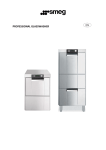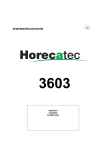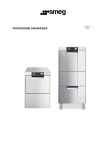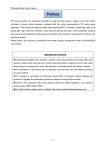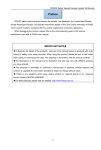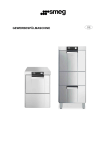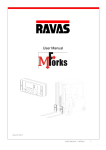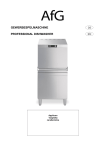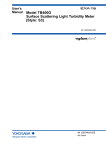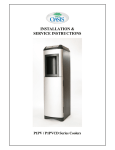Download User manual
Transcript
PROFESSIONAL DISHWASHER 1 Precautions for safety and use 2 Technical data 3 Installation and positioning 4 INSTALLATION INSTRUCTIONS FOR THE AFTER-SALES SERVICE 5 Start-up 6 Settings 7 Malfunctions shown on the display (for the technician) 8 INSTRUCTIONS FOR THE USER 9 Choosing the program 10 Supplementary Functions 11 Maintenance and cleaning 12 Troubleshooting 13 Malfunctions shown on the display (for the user) You are advised to read all the instructions in this manual carefully to become familiar with the right conditions for the proper use of your dishwasher. TECHNICAL INSTRUCTIONS: These are intended for the qualified staff who are to install, commission and test the appliance and carry out any servicing and repairs. INSTRUCTIONS FOR THE USER: These provide recommendations for use, a description of the controls and the correct procedures for cleaning and maintaining the dishwasher. 1 Precautions for safety and use THIS MANUAL IS AN INTEGRAL PART OF THE DISHWASHER AND MUST ALWAYS BE KEPT WITH THE APPLIANCE. POSITIONING, CONNECTIONS, COMMISSIONING, TROUBLESHOOTING AND REPLACEMENT OF THE POWER SUPPLY CABLE MUST BE CARRIED OUT BY SKILLED STAFF. THE DISHWASHER IS INTENDED ONLY FOR PROFESSIONAL USE BY TRAINED STAFF. IT IS DESIGNED TO WASH TABLEWARE (PLATES, CUPS, BOWLS, OVEN DISHES AND CUTLERY) AND SIMILAR ITEMS IN THE RESTAURANT AND INSTITUTIONAL CATERING SECTOR, AND COMPLIES WITH THE INTERNATIONAL STANDARDS ON ELECTRICAL AND MECHANICAL SAFETY (CEI-EN-IEC 60335-258/61770) AND ELECTROMAGNETIC COMPATIBILITY (CEI-IEC-EN 55014-1/-2, 61000-3;4, 50366). THE MANUFACTURER DECLINES ALL RESPONSIBILITY FOR INJURY OR DAMAGE CAUSED BY FAILURE TO COMPLY WITH THE ABOVE REGULATIONS OR DERIVING FROM INCORRECT USE, TAMPERING WITH EVEN JUST ONE PART OF THE APPLIANCE AND THE USE OF NON-ORIGINAL SPARE PARTS. THE APPLIANCE MUST BE IN COMPLIANCE WITH ELECTRICAL SYSTEM SAFETY REGULATIONS. THIS APPLIANCE IS TAGGED UNDER EUROPEAN DIRECTIVE 2002/96/EC ON WASTE ELECTRICAL AND ELECTRONIC EQUIPMENT (WEE). BY MAKING SURE THAT THIS PRODUCT IS DISPOSED OF CORRECTLY THE USER HELPS TO PREVENT POTENTIAL DETRIMENTAL EFFECTS ON HEALTH AND THE ENVIRONMENT. THE SYMBOL ON THE PRODUCT OR IN THE TECHNICAL DOCUMENTATION INDICATES THAT THIS PRODUCT MUST NOT BE TREATED AS ORDINARY DOMESTIC WASTE BUT MUST BE CONSIGNED TO THE SPECIAL COLLECTION POINT FOR THE RECYCLING OF ELECTRICAL AND ELECTRONIC EQUIPMENT. WHEN DECOMMISSIONING THE APPLIANCE COMPLY WITH THE LOCAL WASTE DISPOSAL REGULATIONS. FOR FURTHER INFORMATION ON THE TREATMENT, RECOVERY AND RECYCLING OF THIS PRODUCT, CONTACT THE COMPETENT LOCAL OFFICE, THE DOMESTIC WASTE COLLECTION SERVICE, OR THE SHOP WHERE THE PRODUCT WAS PURCHASED. NEVER PLACE SOLVENTS SUCH AS ALCOHOL OR TURPENTINE, WHICH MIGHT CAUSE AN EXPLOSION, INSIDE THE APPLIANCE. NEVER LOAD DISHES DIRTY WITH ASH, WAX OR PAINTS. NEVER USE THE DISHWASHER OR ANY PART OF IT AS A LADDER, SUPPORT OR STAND FOR PEOPLE, ANIMALS OR ANY OBJECT. LEANING OR SITTING ON THE OPEN DOOR OF THE DISHWASHER MIGHT CAUSE IT TO TIP OVER, PUTTING PEOPLE IN DANGER. NEVER LEAVE THE DISHWASHER DOOR OPEN SINCE PEOPLE MIGHT TRIP OVER IT. DO NOT DRINK ANY WATER LEFT IN THE DISHES OR DISHWASHER AT THE END OF THE WASHING PROGRAM. THE APPLIANCE IS NOT SUITABLE FOR USE BY JUVENILES OR PERSONS WITH REDUCED PHYSICAL, SENSORIAL OR MENTAL CAPACITIES, OR THOSE WITHOUT THE NECESSARY KNOWLEDGE AND EXPERIENCE. SUCH PERSONS MAY ONLY USE THE APPLIANCE UNDER THE SUPERVISION OF A PERSON RESPONSIBLE FOR THEIR SAFETY. 2 2 Technical data TECHNICAL DATA Supply voltage V - convertible to single-phase version V Frequency Hz Max. power absorption at 400V 3N ~ kW Max. power absorption at 230V 1N ~ kW Boiler heating element power at 400V 3N ~ kW Boiler heating element power at 230V 1N ~ kW Tank heating element power kW Water intake pressure kPa (bar) Water intake temperature °C Water hardness (models with softener) °dF Rinse cycle water consumption I Boiler capacity I Tank capacity I Standard cycle duration with intake water at 50°C s Noise level dB(A) Degree of protection IPX Net weight kg Power supply cable type ◄HAR► Fuse A 2,8 kW 6,8 kW 400V 3N ~ C S ----5x2,5 16A 3P+N 230V 1N ~ C 2,8 --kW 6,8 5x2,5 kW 400V 3N ~ 230V -1N ~ 50 6.8 2.8 6.0 2.0 0.8 100-600 (1 ÷ 6) 15°C – 60°C 15°dF-60°dF 3.5 7+1 11 90/150/240/variable 4 H07RN-F 4 C = Power Supply Cable. S = Master Switch R C Q E P S T M 3 LOWER BACK PANEL FILLER HOSE EARTH TERMINAL ELECTRICITY SUPPLY CABLE PERISTALTIC HOSES DRAIN HOSE EXTERNAL DISPENSER POWER SUPPLY CABLE ENTRY POINT TERMINAL BOARD 3 Installation and positioning INSTALLATION and POSITIONING Bring the dishwasher to the installation site, remove the packaging and check the appliance and components for damage; any damage found must be reported to the transporter in writing. The packaging components (plastic bags, expanded polystyrene, nails, etc.) must not be left within reach of children and pets since they are potentially dangerous. All packaging materials used are environment-friendly. They can be kept without constituting any hazard, or may be disposed of at a specialist waste disposal centre. The plastic components suitable for recycling are marked as follows: PE polyethylene: external packaging film, bag containing the instructions, protective bags. PP polypropylene: straps. PS expanded polystyrene: corner guards, top of packaging. Wooden and cardboard components can be disposed of in accordance with the relevant regulations. When the product is decommissioned it must not be dumped in the environment; it must be disposed of in accordance with the relevant regulations. All metal parts are in stainless steel and can be removed. The plastic parts are marked with the symbol identifying the material used. Models with aquastop The aquastop device prevents flooding in the event of water leaks. In these models, the water intake hose is fitted with a solenoid valve. Do not cut the hose and do not drop the solenoid valve into water. In the event of damage to the water intake hose, disconnect the appliance from the electricity supply. POSITIONING: Caution: the indoor system and premises in which equipment for institutions is installed must comply with the relevant regulations. The manufacturer declines all liability for direct or indirect injury or damage deriving from failure to comply with these regulations. Before installation, check that there are no objects or materials in the vicinity which may be damaged by steam or splashes of washing solution, or that any such items are suitably protected. Place the dishwasher in the chosen point and remove the protective film. Level the dishwasher (with the aid of a spirit level) on its adjustable feet to ensure that it is stable; all other mounting solutions must be approved by the manufacturer. 4 4 INSTALLATION INSTRUCTIONS FOR THE AFTER-SALES SERVICE 4.1 Water connection Water supply and drain connection: The water pipelines and electricity supply cable lead out of the bottom right-hand corner of the appliance. Connect the water intake hose to a connector with ¾” gas threaded fitting, fitting the filter A provided (in models with aquastop, the filter and ringnut form a single unit). The connection to the water mains must only be made with new hoses; the use of old or worn hoses is not permitted. The dynamic intake pressure must be between 1 and 6 bar; if it is higher, installation of a pressure reducer is recommended. It is essential to fit a main stop tap on the water intake pipeline; the tap must be accessible after installation of the appliance, so do not install it behind the dishwasher. The stated cycle duration refers to appliances supplied with hot water at 50°C. If the appliance is supplied with cold water, the cycle duration might increase depending on the intake water temperature, since the dishwasher is fitted with the HTR system, which requires set temperature and pressure for rinsing. Drainage: The dishwasher is fitted with a drain pump and can operate with drain connections on the floor or wall. Caution: make sure that the intake and drain hoses are not bent, constricted or crushed after installation. If the drain connection is to an outlet with valve, the maximum height of the drain is reduced to 600 mm. In all cases, after installation check that the drain is fully functional by pumping out the tank completely (P0 cycle). 5 4.1 Electrical connection The dishwasher and any additional equipment must be connected to the electrical system by authorised, skilled staff, in accordance with the relevant regulations; also comply with the technical instructions for the connection. The total rated power is stated on the appliance’s technical data plate. The electrical protection devices fitted for the dishwasher must serve this appliance only. The user must have a master switch and a differential safety breaker, with rating suitable for the machine’s characteristics, installed on the electricity supply line in accordance with the relevant regulations. These switches must be installed close to the dishwasher, be easily accessible after installation, and provide complete disconnection from the electrical mains in overvoltage class III conditions. Warning !!! The dishwasher is always powered up unless the master switch is turned off. Connect the appliance to the user’s earth system. The terminal for the connection is in the bottom right-hand corner of the appliance. ‐ The earth wire (PE) is yellow-green in colour, the neutral wire (N) is blue and the live wires (L1, L2, L3) are black, grey and brown. In the event of single-phase connection (230V-1N~) the connection to the electrical mains must be made using a cable with plug compliant with the relevant regulations.. ‐ IN THE EVENT OF DAMAGE TO THE SUPPLY CORD, HAVE IT REPLACED BY THE MANUFACTURER OR AN AUTHORIZED TECHNICAL SERVICE CENTRE IN ORDER TO AVOID ANY RISK. 6 5 START-UP FIRST START-UP The electrical protection system must undergo a functional test before the appliance is put into operation. The appliance must be installed and/or inspected by the qualified staff, who will start it up for the first time and provide the relevant operating instructions. PREPARING FOR USE Important: The rinse aid dispenser is fitted on all models, the detergent dispenser only on some. If both dispensers are present put the external detergent and rinse aid containers in place and insert the respective intake hoses on the rear of the machine into them. Red hose: detergent blue hose: rinse aid Before inserting the hoses into the containers, fit the weights (needed to ensure that they always draw in liquid from the bottoms of the containers) and the filters onto their ends as shown. If the detergent dispenser is not factory-fitted, it can be by ordering the relative kit. As an alternative an external dispenser can be fitted, making the electrical connection by means of an H05 RNF 2x0.5 mm electrical cable, which can be laid along the route shown in the TECHNICAL DATA diagram and connected as shown in the wiring diagram supplied with the dishwasher. The dispenser must operate on 230V/50 Hz with maximum power absorption of 15 W. Connect to the detergent dispenser outside the dishwasher using the red hose mentioned above. IMPORTANT: Whenever the type of detergent or rinse aid is changed, it is ABSOLUTELY ESSENTIAL to flush out the peristaltic pumps by placing the external intake pipes in water for a few cycles. Always use only products specifically recommended for use in a dishwasher. The internal pipes of the detergent and rinse paid pumps should be replaced by the After-Sales Service every 12 months or 15,000 wash cycles. Failure to comply with this recommendation leads to forfeiture of the warranty entitlement on the appliance’s water system. 6 SETTINGS SETTINGS During start-up, the functions/parameters listed below must be set or adjusted: On first installation, a series of operations can be performed to allow the dishwasher to be customised to the user’s needs. A short testing cycle can also be performed to verify operation of all the components. To perform these operations, access “programming mode” as explained below 7 6.1 Dishwasher parameter modification procedure: Indicator lights as follows: off; green; orange; flashing. on/off button for a few Access “programming mode” by pressing the seconds (UnLo 1:58 will appear on the display) with the appliance on (after the filling and heating phase); at the “beep", release the button and press it again quickly within 0.5 seconds. Keep pressing the button again to scroll through all the modifiable parameters in the following order: Rinse aid delivery amount Detergent delivery amount Rinsing temperature Washing temperature Start-on/start-off. Set at “on” to start the cycle when the door is closed. Set at “off” for cycle start after confirmation with the start button Regeneration frequency, depending on water hardness (if softener is installed) Customisation of duration of program P4. N.B.: the machine must be set on “P4”, see “6.7 Setting program P4 duration”. Displaying the cycle count When scrolling through the appliance parameters the item “tc 88888” , the total count of the cycles the dishwasher has performed since installation, will be found. This parameter cannot be modified or reset unless the software is reprogrammed. 8 Indicator lights as follows: off; green; orange; flashing. 6.1.1 Setting up rinse aid delivery Modify the value of the parameter by pressing . RINSE AID Delivery time Delivery (s) quantity (c.c.) 0 6 12 18 24 30 * 26 48 * default value (factory preset) 0,0 0,7 1,3 2,0 2,7 3,3 4,0 5.3 6.1.2 Setting up detergent delivery DETERGENT Modify the value of the parameter by pressing . * default value (factory preset) Delivery time (s) Delivery quantity (c.c.) 0 0,0 4 1,7 8 3,3 12 * 5,0 16 6,7 20 8,3 24 10,0 6.1.3 Rinsing temperature setup Modify the value of the parameter by pressing (Default value: 85°C) Min. 71°C – max. 85°C . Modify the value of the parameter by pressing (Default value: 62 °C) Min. 52°C – max. 62°C . 6.1.4 Washing temperature setup Indicator lights as follows: off; green; orange; flashing. 9 6.1.5 Autostart function Modify the parameter (ON/OFF) by pressing . Set at “on” to start the cycle when the door is closed. Set at “off” for cycle start after confirmation with the start button 6.1.6 Regeneration frequency setup (models with softener) • Default value: H00; modify the parameter to suit the mains water hardness. Generally H03 will be satisfactory for most users. At first use, the salt tank has to be filled. It is subsequently sufficient simply to fill up with regenerating salt when necessary. Hardness Hardness Setting level (°dH german (°dF French Modify the value degrees) degrees) of the parameter Regeneration off Regeneration off H00 by pressing . 8,5 15 H01 11 20 H02 17 30 H03 22,5 40 H04 28 50 H05 Regeneration cycle duration: 12 minutes 33,5 60 H06 • • With values over 60°dF an external water treatment device must be used and the regeneration frequency must be set on H00. 6.1.7 Customisation of duration of program P4 The duration of program P4 can be customised from 5 to 20 minutes using the appliance parameter modification procedure, but the dishwasher must be set on program P4. After setting program P4 access the programming procedure and scroll through to “ınF” (last parameter to appear) then press the button to modify the duration of the cycle (from 5 to 20 minutes) After a few seconds without the user pressing any buttons, the display will return to the normal operating status and the modifications will be saved. 10 6.2 Starting the peristaltic pumps – rapid filling of detergent and rinse aid delivery circuit Perform after the parameter modification procedure explained in the previous point. Indicator lights as follows: off; green; orange; flashing. With the dishwasher powered up, access “programming mode” by pressing the on/off button for a few seconds; at the “beep”, release the button and press it again quickly within 0.5 seconds. The peristaltic pumps continue to operate until the same buttons are pressed again. The rinse aid and detergent symbol lights remain on as long as work is in progress; bear in mind that the rinse aid peristaltic pump fills the circuit in about 7 minutes, while for the detergent it only takes 2 minutes. 7 MALFUNCTIONS SHOWN ON THE DISPLAY The dishwasher is able to identify a number of malfunctions and show them on the display. If the problem persists after the dishwasher has been switched off and back on, proceed as described below: Err01 The anti-flooding system has been activated (for the relevant models only). Large water leak : check the origin of the problem. Err04 Tank temperature probe malfunction Tank temperature probe disconnected or not working Check dynamic pressure in intake system, inspect water intake filter and clean if necessary. Err05 Tank water filling malfunction If the problem persists: - tank pressure switch has failed (continuous empty reading) - leak from pipe connected to air trap - valve vent exhaust pipe blocked Water pump-out malfunction Inspect the filters for dirt and that the drain hose is not blocked, bent or crushed. Check that the drain pump is not blocked by dirt by removing the insert on the sump (from inside the tank) If the problem persists: ‐ with the tank empty: tank pressure switch defect (the contact is locked on full) ‐ with tank full: drain pump has failed Tank water level too high - with tank full: see above (water pump-out malfunction) - with tank empty: safety pressure defect (the contact is locked on full) Err23 Boiler heating malfunction (does not heat up) -circuit board relay failure, - contactor failure. - boiler safety thermostat failure, - boiler temperature probe faulty or incorrectly positioned - water continues to enter the tank due to tank pressure switch defect Err24 Boiler temperature probe malfunction boiler temperature probe disconnected or not working Err06 Err09 11 Check that the water intake tap is on and the dynamic pressure in the intake system, inspect the water intake filter and clean if necessary. Err25 Boiler water filling malfunction Err26 Boiler emptying malfunction - check that rinsing spray arm nozzles are clean - boiler pressure switch has failed (continuous full reading) - rinsing pump not working Err27 Boiler emptying malfunction – with tank full Boiler pressure switch has failed (continuous full reading) Err28 Boiler heating malfunction (overheating) -circuit board relay failure, or - contactor failure If the problem persists: - boiler pressure switch has failed (continuous empty reading) - pipe leaking/disconnected 8 INSTRUCTIONS FOR THE USER 8.1 Control panel On-off button Program selection button Start CONFIRM/PAUSE button Total emptying button (tank and boiler) Additional function selection button L1 Main power on light L2 Intake/standby cycle in progress light (orange/green) L3 Pump-out in progress light No rinse-aid symbol (if a system for monitoring outside the dishwasher is provided) Tank heating element on symbol No salt symbol (if softener is fitted) Boiler element on symbol No detergent symbol (if a system for monitoring outside the dishwasher is provided) 12 8.2 Before washing Use only detergents and rinse aids for industrial dishwashers. Do not use detergents intended for hand washing. We recommend the use of Smeg products, specially developed for this dishwasher. When topping up the tanks, take care not to swap the products; this might damage the dishwasher and cause malfunctions. Do not mix different detergents; this would damage the dispenser device. Industrial dishwasher detergents may cause serious irritations. Comply carefully with the instructions provided by the detergent producer on the pack. Turn on the mains water tap (user) 8.3 Check: That there is That the filters are in place, regenerating salt the spray arms rotate, and in the relative there are no foreign bodies in container (if the dishwasher. fitted). The level of detergent and rinse aid in the containers. Switch on the master switch (user): the word “OFF” appears on the display. FIRST USE EACH DAY (tank and boiler empty) Indicator lights as follows: off; green; Display shows orange; flashing. Actions and what happens With the door closed: Press and hold it down the dishwasher fills the tank after the water in the boiler has heated up; light L2 shows orange and the boiler heating element symbol appears on the display. Wait for P1 to appear and LED L1 to change from orange to green; the tank heating element comes on until the set temperature is reached. The duration of this stage may vary depending on the mains water temperature and on the single-phase connection. Press the button to display the tank (left) and boiler (right) temperatures. Load the dishes Select the program required by pressing . Confirm the program start by pressing and holding it down for 1 second (light L2 changes from green to orange). 13 Cycle in progress, the time left until the end of the cycle is displayed. If the door is opened “CLOSE” flashes and the program stops; when it is closed again the program restarts from the beginning. At the end of the program “End” flashes Unload the dishes When the door is closed again, the last program is repeated. 8.4 Program change With the door closed, to change to a fresh program instead of repeating the last one, press the button. The programs available are displayed (light L2 changes from orange to green). If a program has already started, hold interrupt it. change the program by pressing down to . Confirm the program start by pressing and holding it down for 1 second (light L2 changes back to orange). N.B.: During heating of the water in the boiler, the tank heating element may appear on the display. and boiler heating element symbols Filter presence sensor (on some models only) The filter is fitted with a sensor which checks that it is properly fitted; if it is not in the correct position, the word “FiLter” appears on the display. 14 9 CHOOSING THE PROGRAM TYPE OF DIRT PROGRAM DURATION (*) P1 Glasses P2 Glasses, cups and plates with light dirt P3 Very dirty dishes and cutlery P4 Depending on the duration set. Short, about 1’ 30” 1’ with glassware function active. Average, about 2’ 30” 2’ with glassware function active. Long, about 4’ 5’30” with sani function active. As required from 5 to 20'. (*) The cycle duration stated above refers to three-phase appliances supplied with hot water at 50°C. If the appliance is supplied with cold water, the cycle duration might increase depending on the intake water temperature, since the dishwasher is fitted with the HTR system, which requires set temperature and pressure for rinsing. 10 SUPPLEMENTARY FUNCTIONS Indicator lights as follows: off; green; orange; flashing. To select a supplementary function, when the program required is shown on the display (P1, P2, P3 or P4) press the button. Only one supplementary function can be selected for each program. 10.1 Selecting the “glassware” function (available in P1-P2) Reduces the program’s rinsing temperature and duration Select the program required (7.4 OPERATION) Hold down to select the glassware function then to confirm the program start. 10.2 Selecting the “extra rinse” function (available in P1-P2-P3-P4) Extends the duration of the rinse Select the program required (7.4 OPERATION) Hold down to select the extra rinse function then to confirm the program start. 15 10.3 Selecting the “sanitisation” function (only available in P3) Increases the washing and rinsing temperature and the program duration Select the program required (7.4 OPERATION) Press to select the sanitisation function then confirm the program start. to N.B.: ‐ the supplementary function remains selected until the program is changed or the dishwasher is switched off ‐ button. by pressing the During the selected program, the display alternates between showing the supplementary function and the duration. LOADING THE DISHES Plates The basket is able to take 12 soup plates or 18 dinner plates. Remove solid residues (bones, fruit peel, stones, etc.) and soak plates with dried residues of cheese, egg, etc. in water before loading in the dishwasher. Glasses Load glasses upside down. Cutlery Use the special basket(s). Load cutlery loose, preferably with the handle at the bottom, taking care not to injure yourself with fork prongs or knife blades. TOTAL PUMP-OUT AT THE END OF THE DAY The dishwasher is able to perform an automatic cleaning cycle at the end of the day. Press the button; “UnLo” and the duration appear on the display. Confirm by pressing ; light L2 turns orange. At the end of the pump-out, the appliance sets in “OFF” status. 16 After a total pump-out the filters should be cleaned as described above. Never switch the dishwasher off with water in the tank; pump out first. TOTAL PUMP-OUT AT THE END OF THE DAY + Resin regeneration (form models with water softener) From time to time, on models with water softener, before the total pump-out at the end of the day the user will automatically be reminded to carry out the resin regeneration cycle, required after a number of washes which depends on the hardness of the water (about 30 for average setting H03). In this case the sequence will be as follows: Press the pump-out button ; “rEgE” and the duration appear on the display. Confirm by pressing ; light L2 turns orange. At the end of the pump-out, the appliance sets in “OFF” status. Topping up with regenerating salt (for models with water softener) Salt must be added when the “no salt” light ( ) appears on the display. Top up with salt when there is no water in the tank to prevent washing water from getting into the water softener device. Caution: use only salt of the specific type, do not use cooking salt. The salt tank has a capacity of about 1 kg of coarse-grained salt. The salt reservoir is in the bottom of the tank. After removing the basket, undo the cap and pour the salt in using the funnel supplied. Remove any salt residues around the opening before screwing the cap back on. 11 MAINTENANCE AND CLEANING Although no particular scheduled maintenance is required, users are advised to have the dishwasher checked by a specialist technician twice a year. N.B.: the manufacturer accepts no liability for wilful damage or damage deriving from carelessness, neglect, failure to comply with instructions, regulations and standards or incorrect connections. 11.1 Daily cleaning The dishwasher has IPX4 protection, but the use of direct water jets for cleaning is forbidden. Cleaning the filter during the day In case of particularly heavy-duty working conditions, the filter should be cleaned every 30-40 cycles, keeping the machine in operating conditions; to do this, carry out the “partial tank pump-out” routine (program “P0”). Press the button, and hold it down, until “P0” and the duration of 1’ appear on the display. Confirm by pressing 17 ; light L2 turns orange. At the end of the pump-out the word “End” flashes on the display. The display returns to showing “P1”. Close the door again to start filling the tank prior to performance of a new wash cycle. Remove the filters (simply lift them out as shown here), taking care that no large residues fall into the sump underneath. Clean them to remove residues and rinse with plenty of water, then put them correctly back in place; do not use sharp or pointed tools. Clean away any limescale deposits to prevent excessive build-ups; ‐ If possible, leave the door ajar when not in use; ‐ Clean surfaces thoroughly and often with a damp cloth; use neutral, non-abrasive detergents which do not use chlorine compounds, which corrode and damage stainless steel. Do not use the products mentioned above even when cleaning the floor underneath or in the vicinity of the dishwasher, to ensure that fumes or drops cannot damage the steel surfaces. IMPORTANT: The dishwasher automatically performs program “P0” at the start of the day if water has been left in the tank and has dropped below the temperature of 40°C 11.2 Periodic checks Remove the top and bottom spray arms by unscrewing the central screw and unscrew the caps from the ends of the rinsing arms as shown. Do not unscrew the nozzles. Clean the holes and nozzles under a jet of clean running water; do not use tools which might cause damage. Reassemble the spray arms with care. Clean the outside of the appliance with a damp cloth and neutral soap, rinsing and drying thoroughly. 11.3 Lengthy periods out of use If the dishwasher is to be out of use for a fairly long period of time, the detergent and rinse aid dispenser devices must be emptied to prevent crystallisation and damage to the pumps: Remove the intake hoses from the detergent and rinse aid containers and place them in a container of clean water, then perform a few wash cycles followed by a complete pump-out. Finally, turn off the master switch, close the water intake valve and leave the door ajar until the interior is completely dry. The detergent and rinse aid intake hoses must be put back into the containers when the dishwasher is returned to service, taking care not to swap them over (red hose = detergent, blue hose = rinse aid). 18 12 TROUBLESHOOTING If the system fails to pump out because the drain pump is fouled (as a result of incorrect filter positioning), proceed as follows: Bale out the dishwasher with a basin and disconnect it from the electrical mains. Unscrew the screw A, release the tang B and lift it. Check that the impeller of the drain pump underneath the cover turns freely, and is free from dirt, limescale residues, or pieces of glass. Never use tools, screwdrivers, scissors, etc. PROBLEM POSSIBLE CAUSE POSSIBLE REMEDY LIGHT S1 DOES NOT COME ON Mains power failure Check electrical mains connection. WASHING PROGRAM NOT START DOES POOR WASHING RESULTS INADEQUATE RINSING STAINS ON CUTLERY GLASSES AND The dishwasher finished filling. has not yet Wait for the word FILL to go out. The word CLOSE remains on the display If the word CLOSE remains on the display even with the door closed, call the after-sales service. Spray arm washing holes blocked by dirt or limescale Remove spray arms and clean them (10.2 Periodic checks) Filter fouled See “Cleaning the filter during the day” Too little or unsuitable detergent or rinse aid Check type and quantity of detergent. Detergent intake blocked Check that the detergent intake pipe underneath the filter is unobstructed (T in photo). No or not enough detergent or rinse aid being supplied: detergent or rinse aid not being taken from the relative container. Pipe inside detergent and/or rinse aid peristaltic pump worn or broke, have it replaced by the After-Sales Service. Plates/glasses badly arranged Arrange plates/glasses correctly. Low washing temperature Check temperature shown on the display, call the after-sales service if less than 50° Inappropriate cycle set Increase washing duration, especially if dishes are very dirty or dirt has dried on. Spray arm nozzles fouled Limescale in boiler Check that nozzles are clean, and ensure that the softener is working properly (if installed). Rinse aid unsuitable or not being delivered correctly. Water hardness above 12°dF or large amounts of dissolved salts Check container of rinse aid and whether type is suitable for the mains water- If the problem persists, contact the after-sales service. 19 WATER IN TANK AFTER PUMPOUT Drain hose incorrectly positioned or partially obstructed. Check that the dishwasher drain hose and rain are unobstructed and the drain is not too high up; see connection diagram. 13 MALFUNCTIONS SHOWN ON THE DISPLAY The dishwasher is able to identify a number of malfunctions and show them on the display. If the problem persists after the dishwasher has been switched off and back on, proceed as described below: Err01 The anti-flooding system has been activated (for the relevant models only). Contact the After-Sales Service. Err04 Tank temperature probe malfunction Contact the After-Sales Service Tank water filling malfunction Check that the water intake tap is on and the dynamic pressure in the intake system, inspect the water intake filter and clean if necessary. If the problem persists, contact the After-Sales Service. Err06 Water pump-out malfunction (dishwasher is left full of water) Inspect the filters for dirt and check that the drain hose is not blocked, bent or crushed. Check that the drain pump is not blocked by dirt; proceed as described in point “10.2 Periodic checks”. If the problem persists, contact the After-Sales Service. Err09 Tank water level too high Err23 Boiler heating malfunction (does not heat up) Err24 Boiler temperature probe malfunction Err05 Err25 Boiler water filling malfunction Err26 Boiler emptying malfunction Err27 Boiler emptying malfunction – with tank full Err28 Boiler heating malfunction (overheating) Contact the After-Sales Service. Check that the water intake tap is on and the dynamic pressure in intake system, inspect water intake filter and clean if necessary. If the problem persists, contact the After-Sales Service. Check that the rinsing spray arm nozzles are not fouled If the problem persists, contact the After-Sales Service. Contact the After-Sales Service. 20





















